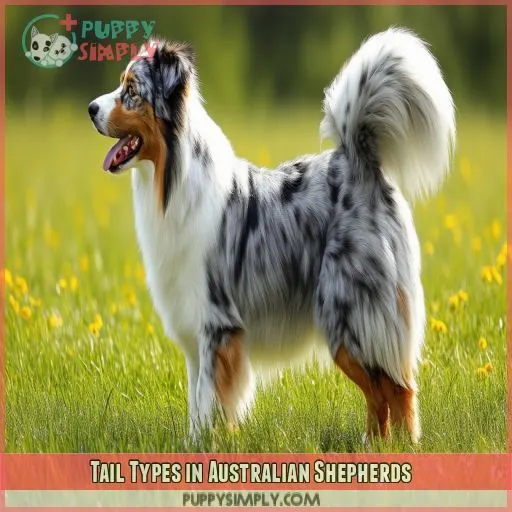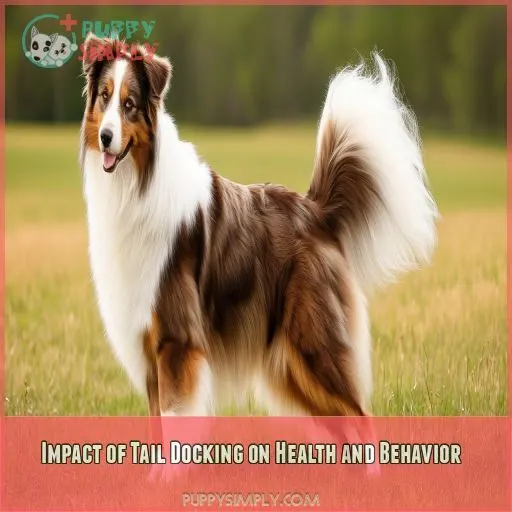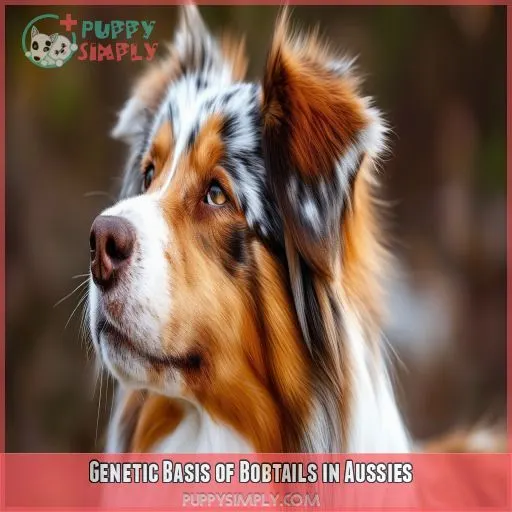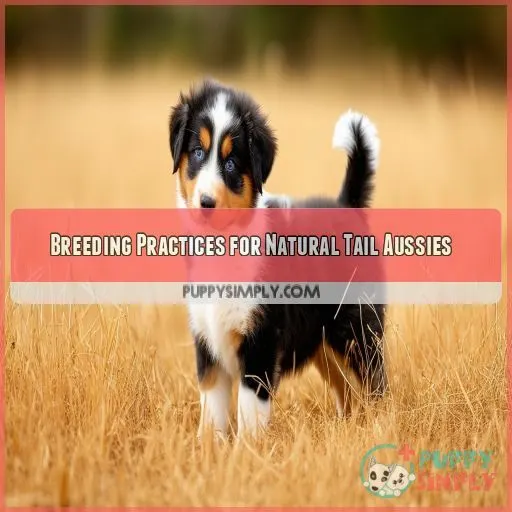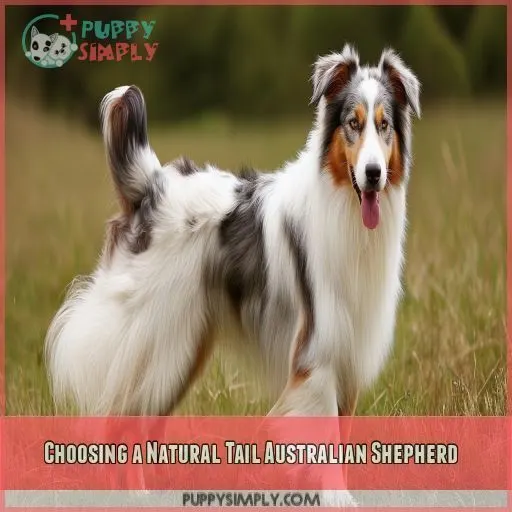This site is supported by our readers. We may earn a commission, at no cost to you, if you purchase through links.

Tail docking in this breed is commonplace, but ethical concerns are growing.
In this article, we’ll discuss the history of tail docking, weigh the pros and cons, and explore the health and behavioral implications.
We’ll also delve into the genetic basis of bobtails and guide you in choosing a natural-tailed Aussie pup.
Table Of Contents
- Key Takeaways
- Historical Perspective on Tail Docking
- Traditional Justifications for Tail Docking
- Contemporary Views on Tail Docking
- Ethical Considerations in Tail Docking
- Tail Types in Australian Shepherds
- Impact of Tail Docking on Health and Behavior
- Genetic Basis of Bobtails in Aussies
- Breeding Practices for Natural Tail Aussies
- Legislation and Bans on Tail Docking
- Choosing a Natural Tail Australian Shepherd
- Frequently Asked Questions (FAQs)
- Conclusion
Key Takeaways
- Ditch the docking and embrace the wag: Natural tails are a treasure, not a nuisance. They serve as a built-in communication tool, helping your Aussie express emotions, from joy to fear and even "leave me alone" vibes.
- Prioritize health over looks: While docking may seem convenient, it can result in pain, nerve damage, and balance issues for your pup. It’s akin to putting a Band-Aid on a broken bone – addressing the appearance without treating the actual issue.
- Choose ethical breeders for happy tails: Opt for breeders who prioritize the well-being of their puppies. These breeders will favor natural tails and avoid pairing two bobtails, which may lead to health complications.
- Help spread the word and wag those tails: Join the movement to put an end to unnecessary tail docking. Share this information with other Aussie enthusiasts, and together, let’s make natural tails the standard. Remember, "A tail-less Aussie is like driving a car without a steering wheel – something essential is missing!
Historical Perspective on Tail Docking
You might be surprised to learn that tail docking isn’t a modern practice. It’s roots stretch back to ancient Roman times when it was believed to prevent rabies. Fast forward to the 1950s, and you’ll find American breeders adopting the practice for Australian Shepherds. Why? To meet breed standards and gain AKC acceptance.
But here’s the kicker: not all Aussies need their tails docked. About 20% are born with natural bobtails, thanks to a genetic quirk. This throws a wrench in the whole "necessity" argument, doesn’t it?
The practice has evolved alongside the breed’s working environment. As Aussies moved from harsh herding conditions to family homes, the need for tail amputation has diminished. Yet, tradition dies hard. Many breeders still dock tails, clinging to outdated breed standards. It’s time to wag goodbye to this unnecessary practice.
Traditional Justifications for Tail Docking
As you explore deeper into the realm of Australian Shepherds, you’ll encounter traditional justifications for tail docking that have endured for generations. These reasons originate from historical practices and cultural perspectives that shaped the breed’s development. While modern animal welfare concerns have challenged these notions, it’s vital to comprehend the origins of this controversial practice.
Proponents of tail docking often cite the following reasons:
- Injury prevention during herding work
- Improved hygiene in working environments
- Conformity to breed standards for show dogs
Historically, tail docking was believed to prevent injuries and health problems in working dogs. However, these justifications are increasingly scrutinized as more Aussies become companion animals rather than working dogs. The practice’s origins can be traced back to ancient beliefs about rabies prevention, though this has long been debunked. As you consider adopting an Aussie, it’s important to weigh these traditional arguments against contemporary ethical guidelines and animal welfare concerns.
Contemporary Views on Tail Docking
While tradition once justified tail docking, contemporary views have shifted dramatically. You’ll find that many breeders now recognize the importance of preserving an Aussie’s natural instincts and emotional expression. As our understanding of canine welfare has evolved, so too have the ethical dilemmas surrounding this practice.
Today, you’re likely to encounter heated debates about the medical implications and health risks associated with docking. Critics argue that it’s an unnecessary procedure that can lead to long-term health problems. On the flip side, proponents still cite injury prevention and easier grooming as benefits.
The discovery of the NBT gene, responsible for natural bobtails in some Aussies, has further complicated the issue. It’s opened up new avenues for breeders who want to maintain the bobbed look without resorting to surgical intervention. As you navigate these waters, remember that your Aussie’s welfare should always be the top priority.
Ethical Considerations in Tail Docking
When considering tail docking for your Australian Shepherd, you’ll face important ethical questions about pain versus tradition. You’ll need to weigh the natural communication benefits of an intact tail against the unnecessary cosmetic procedure of docking, which can impact your pup’s health and behavior.
Pain Versus Tradition
As you contemplate the ethics of tail docking, you’re confronted with a clash between tradition and suffering. While breed standards and the history of working Aussies support docking, it’s imperative to balance this against the pain inflicted on puppies. Here are four key considerations:
- Pain management during docking
- Necessity for companion animals
- Long-term effects of cosmetic alterations
- Alternative breed standards for natural tail Aussies
Natural Communication Benefits
You’ll find that your Aussie’s tail is a significant communication tool. It’s not just a furry appendage; it’s an integral part of their emotional expression and social interactions.
Through tail movements, your dog conveys happiness, fear, or alertness. This natural body language helps them interact with other dogs and humans.
Preserving their tail maintains their breed identity and allows for clearer emotional cues, enhancing your bond and understanding.
Unnecessary Cosmetic Procedure
You might wonder why tail docking is still practiced when it’s largely cosmetic. Breed standards often favor shorter tails, but this doesn’t justify altering a dog’s natural anatomy.
While some argue it prevents hygiene issues, proper grooming achieves the same result. Tail length doesn’t affect health, and docking can impact a dog’s emotional well-being.
It’s time to prioritize your Aussie’s comfort over outdated aesthetic preferences.
Tail Types in Australian Shepherds
When you’re observing Australian Shepherds, you’ll notice three distinct tail types. First, there’s the natural bobtail, typically 3-4 inches long, which about 20% of Aussies have due to genetics. Then, you’ve got the natural full tail, which is long and feathered, ideal for expressive tail wagging. Finally, there’s the docked tail, artificially shortened to no more than 4 inches.
Tail length and shape can vary depending on bloodlines, with some bobtails even sporting a slight curve. It’s imperative to recognize that tail health isn’t just about aesthetics – it plays a role in your dog’s balance and communication. regular tail grooming is essential, especially for those with longer tails, to prevent matting and keep them looking their best.
Impact of Tail Docking on Health and Behavior
When you choose to dock your Aussie’s tail, you’re altering more than just their appearance. The procedure can have lasting impacts on their health and behavior. Pain management is essential, as docking without proper anesthesia can lead to chronic discomfort. You might notice behavior modification in your pup, as they adapt to life without a essential communication tool. Tail-less Aussies may struggle to express themselves fully, leading to potential misunderstandings with other dogs and humans.
Health risks associated with docking include nerve damage, chronic pain, and even spinal issues. Welfare concerns extend beyond the initial procedure, as your Aussie may face challenges in balance and temperature regulation. Communication impairment can affect your dog’s social interactions, potentially leading to anxiety or aggression.
Genetic Basis of Bobtails in Aussies
You might be surprised to learn that some Aussies are born with naturally short tails, thanks to a genetic quirk. The bobtail gene in Australian Shepherds is an incomplete dominant trait. This means you only need one copy of the gene for a pup to have a bobtail. But here’s the catch: if both parents pass on the gene, it can be fatal for the puppy.
Bobtail genetics don’t determine tail length or shape, so you’ll see variety even among natural bobtails.
While some breeders focus on producing bobtail puppies, it’s imperative to prioritize health over appearance. The bobtail gene can lead to spinal issues in some cases.
Breeding Practices for Natural Tail Aussies
When breeding for natural tail Aussies, you’ll need to make some ethical choices. First, avoid breeding two bobtail Aussies together, as this can lead to health issues in puppies. Instead, pair a natural tail Aussie with a bobtail or another natural tail dog. Keep in mind that tail length can vary, even among natural tail pups.
As a responsible breeder, you’ll want to contemplate the health impacts of your breeding decisions. Remember, a longer tail doesn’t necessarily mean more grooming headaches. With the right techniques, maintaining a natural tail is a breeze.
Educate potential owners about the benefits of natural tails, such as improved communication and balance. By prioritizing ethical breeding practices, you’re not just producing puppies – you’re championing a cause.
Your commitment to natural tails can help shift perceptions and create happier, healthier Aussies.
Legislation and Bans on Tail Docking
As responsible breeders move in the direction of natural tails, you’ll find that legislation is catching up with ethical concerns. Tail docking legality varies widely across the globe, with many countries taking a stand against this practice. In the UK, Australia, and parts of Europe, it’s been banned for non-working dogs, reflecting growing awareness of animal welfare. These bans have sparked debates about docking alternatives and pain management during necessary procedures.
You’ll notice global tail docking trends leaning towards preservation of natural tails, with many kennel clubs adjusting breed standards accordingly. The ethical implications of cosmetic surgeries on animals are under scrutiny, prompting veterinary associations to reconsider their stance. As you navigate this changing landscape, remember that your choices as a breeder or owner can influence these trends. By embracing natural tails, you’re not just following the law – you’re championing animal welfare.
Choosing a Natural Tail Australian Shepherd
When selecting a natural tail Australian Shepherd, you’ll need to weigh the available tail types and their communication advantages. To locate a reputable breeder who provides Aussies with intact tails, start by researching their breeding practices and inquiring about their commitment to ethical, natural tail breeding.
Tail Types Available
With tail docking bans in place, you’ll find more natural tail Aussies available. When choosing your pup, you’ll encounter three main tail types:
- Natural bobtails: Short, 3-4 inches long
- Full-length tails: Long and feathered
- Varied lengths: Due to natural variation
Each type showcases the breed’s characteristics differently. Remember, appearance isn’t everything – focus on function and health. Tail length and shape can vary widely, reflecting the rich diversity within the Australian Shepherd breed.
Communication Benefits
Choosing an Australian Shepherd with a natural tail preserves their ability to express emotions and communicate.
Tail wagging is not always a sign of happiness. It can indicate other moods, like nervousness, fear, or aggression, depending on how the tail moves and its position.
A natural tail enhances social interaction, helping you understand your Aussie’s needs and moods, fostering a deeper connection.
Breeder Selection Process
When selecting an ethical breeder, prioritize those who prioritize the health and well-being of their dogs. Look for breeders who focus on genetic diversity, proper health testing, and ethical breeding practices. Ask about their breeding philosophy, specifically regarding tail length and shape. Request to see the parent dogs to assess their tail types and overall health. Make certain the breeder provides a health guarantee and is transparent about any health issues in the bloodline.
Additionally, observe the breeder’s facilities and puppy-rearing practices. Puppies should be well-socialized, happy, and healthy, with ample space to play and explore. Avoid breeders with cramped, unsanitary conditions or who seem more focused on profit than the dogs’ well-being.
Frequently Asked Questions (FAQs)
Do natural tails affect the price?
You might think a natural tail would be a selling point, but it’s the opposite. Natural tails don’t affect the price, but they’re less desirable to breeders. Breeding two natural bobtails can lead to devastating effects on future litters.
What grooming is needed for natural tails?
Natural tails on Australian Shepherds require regular brushing and de-shedding (using a brush or comb). Shampooing and rinsing are also recommended, with a high-velocity dryer used to blow the coat at a right angle to the skin to improve de-shedding.
Can you dock a tail later?
You can dock a dog’s tail later in life, but this is a more complex procedure. It’s a full amputation and is very painful, requiring general and local anaesthesia.
Do natural tails need more exercise?
No, natural tails don’t need more exercise. However, all dogs need exercise to stay active and socialise with other people and dogs. Just be sure to not over-exercise your dog when they’re young, as this can lead to joint pain and mobility problems later in life.
Are there health issues with natural tails?
Natural tails on Australian Shepherds don’t usually cause health issues. In fact, dogs with docked tails are more likely to experience nerve damage and chronic pain. Natural bob-tail Aussies might’ve kinked tails, but this is unrelated to their health.
Conclusion
All’s well that ends well." So, here we’re at the end of our discussion about natural-tailed Australian Shepherds. We’ve explored the history, justifications, and ethical dilemmas surrounding tail docking in this beloved breed. The practice of tail docking has evolved, with growing concerns about animal welfare and recognition of the natural tail’s advantages.
When choosing an Australian Shepherd pup, consider the ethical implications of tail docking and opt for a natural-tailed companion. Remember to research reputable breeders who prioritize the health and happiness of their pups over cosmetic trends. By embracing the natural tail, you support the Aussie’s inherent beauty, communication, and well-being.
I hope this article has shed light on the importance of ethical breeding practices and empowered you to make informed choices as a responsible dog owner.
Natural Tail Australian Shepherd Breeder





